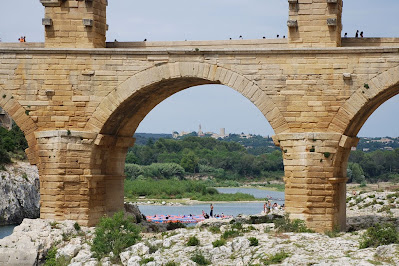I taught Art History at LaGuardia High School in Manhattan for many years, using the Aesthetic Realism Teaching Method. It is based on the education founded by Eli Siegel, the 20th century poet, and critic. I’ve seen this method work in my classroom with thousands of students. For a teacher to know what I’m fortunate to have learned—that the purpose of education and life itself is to like the world on an honest basis—is an absolute necessity! Aesthetic Realism also explains the biggest interference with learning: the desire in a person to have contempt, to get an “addition to self through the lessening of something else."
 |
| Pont-du-Gard, France |
In teaching the unit on the art of ancient Rome, my class studied how the keystone arch was central to its great architectural structures. There is the Pont du Gard, a powerfully-built aqueduct consisting of a series of graceful keystone arches, built in the 1st century BC in Nimes, France. What makes this structure beautiful—and also made my students change, and want to learn—is in this principle stated by Eli Siegel: "All beauty is a making one of opposites, and the making one of opposites is what we are going after in ourselves."
This aqueduct with its repeating curves and strong vertical supports, carried 100 gallons of water per day over a distance of 30 miles for each city resident, making possible the fountains and public water works. "Clearly this is powerful, but does it have something else?" I asked. “Is it also ever so graceful, with those curves?” I’ve seen that students—including the toughest young men—long to be both strong and graceful, or gentle, and suffer because they feel they can’t be both. They think if they have gentleness they'll be weak and people will take advantage of them. My class began to see that this aqueduct does something they were hoping to do: it puts opposites together.
One student, David, wanted to know how the aqueduct worked, and we learned that the power of gravity is what made the water flow. Built on an exquisitely calculated decline, from the water's source high in the mountains, the water flowed downward to the city fountains. Rafael was amazed to learn that this aqueduct was designed to withstand the strength of flooding river currents and has remained standing for 2000 years even as more modern bridges in the area have washed out in heavy flooding! "Wow, that's strong!" he said. “What did this strength come from?” I asked. The strength actually depends on that curved, graceful thing—the arch. As we read from our textbook, Gardner’s Art through the Ages, this description of the Pont Du Gard, there was a sense of awe:
"Each large arch spans some 82 feet and is constructed of uncemented blocks weighing up to two tons each."
The class saw the amazing relation of solidity and lightness in this structure. Vocabulary words for the lesson were keystone and voussoir. The voussoirs, I explained, are the wedge-shaped stones fitted around the sides of the arch, and the keystone is the topmost voussoir. The keystone, the last stone placed at the highest point in the arch, locks all the other stones or voussoirs into place. The downward pressure it exerts gives the arch its strength. The other voussoirs, in turn, send a counter pressure upwards on both sides, holding the keystone in place. The strength of an arch, we learned, depends on something that has amazing delicacy—the precision with which the voussoirs are fitted together—and all done without any cement!
The class was thrilled to see that the keystone which is at the center—the thing upon which all that power depends—seems to be the lightest, even the most vulnerable thing, with nothing but space underneath it! George, who rarely showed any emotion, was excited, "That's really cool," he said.
I read sentences from a historic class titled "Architecture Is Ourselves," taught by Ellen Reiss, the Aesthetic Realism Chairman of Education, in which she explained that the arch is a very elemental thing, and one of the big achievements of the human mind:
"The crown of the arch seems unsupported from below: matter is making for this tremendous lightness. The grand moment in arch construction is when the keystone … is inserted: it seems it would fall, but it's the thing that holds the two sides together."
In this arch massiveness is the same as lightness—strength is the same as delicacy or grace. Seeing these opposites as one in a structure that has joined earth, sky, and water for thousands of years, my students had more hope for themselves.


